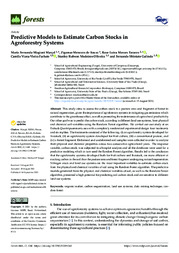Predictive models to estimate carbon stocks in agroforestry systems.
Predictive models to estimate carbon stocks in agroforestry systems.
Author(s): MARÇAL, M. F. M.; SOUZA, Z. M. de; TAVARES, R. L. M.; FARHATE, C. V. V.; OLIVEIRA, S. R. de M.; GALINDO, F. S.
Summary: Abstract: This study aims to assess the carbon stock in a pasture area and fragment of forest in natural regeneration, given the importance of agroforestry systems in mitigating gas emissions which contribute to the greenhouse effect, as well as promoting the maintenance of agricultural productivity. Our other goal was to predict the carbon stock, according to different land use systems, from physical and chemical soil variables using the Random Forest algorithm. We carried out our study at an Entisols Quartzipsamments area with a completely randomized experimental design: four treatments and six replites. The treatments consisted of the following: (i) an agroforestry system developed for livestock, (ii) an agroforestry system developed for fruit culture, (iii) a conventional pasture, and (iv) a forest fragment. Deformed and undeformed soil samples were collected in order to analyze their physical and chemical properties across two consecutive agricultural years. The response variable, carbon stock, was subjected to a boxplot analysis and all the databases were used for a predictive modeling which in turn used the Random Forest algorithm. Results led to the conclusion that the agroforestry systems developed both for fruit culture and livestock, are more efficient at stocking carbon in the soil than the pasture area and forest fragment undergoing natural regeneration. Nitrogen stock and land use systems are the most important variables to estimate carbon stock from the physical and chemical variables of soil using the Random Forest algorithm. The predictive models generated from the physical and chemical variables of soil, as well as the Random Forest algorithm, presented a high potential for predicting soil carbon stock and are sensitive to different land use systems.
Publication year: 2021
Types of publication: Journal article
Keywords: Agroforestry, Agroforestry systems, Carbon sequestration, Data mining technique, Floresta aleatória, Land use, Land use systems, Matéria Orgânica, Mineração de dados, Modelo preditivo, Organic matter, Predictive models, Random forest, Sequestro de carbono, Sistemas agroflorestais, Sistemas de uso da terra, Uso da Terra
Observation
Some of Embrapa's publications are published as ePub files. To read them, use or download one of the following free software options to your computer or mobile device. Android: Google Play Books; IOS: iBooks; Windows and Linux: Calibre.
Access other publications
Access the Agricultural Research Database (BDPA) to consult Embrapa's full library collection and records.
Visit Embrapa Bookstore to purchase books and other publications sold by Embrapa.

